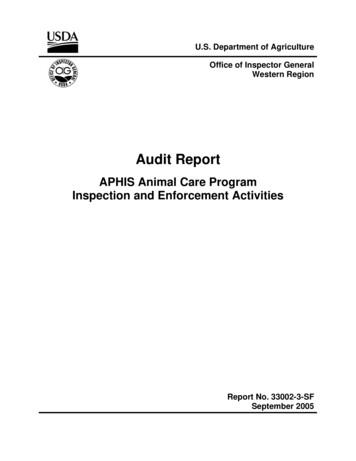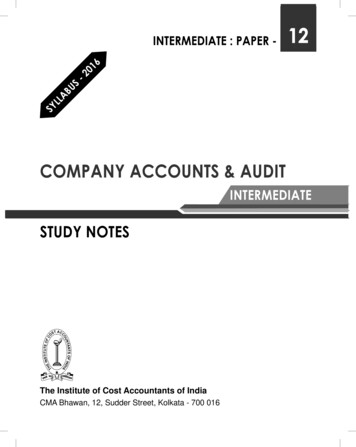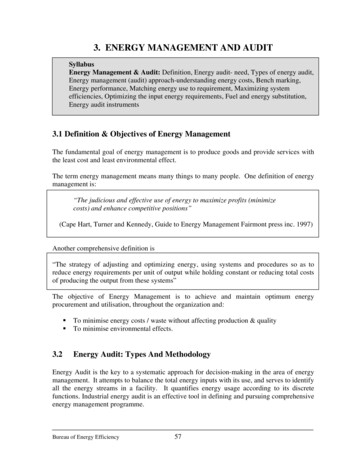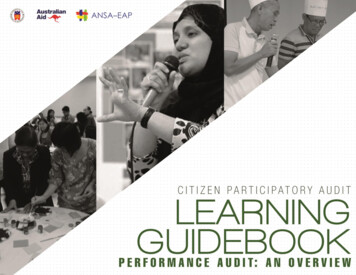
Transcription
U.S. Department of AgricultureOffice of Inspector GeneralWestern RegionAudit ReportAPHIS Animal Care ProgramInspection and Enforcement ActivitiesReport No. 33002-3-SFSeptember 2005
UNITED STATES DEPARTMENT OF AGRICULTUREOFFICE OF INSPECTOR GENERALWashington D.C. 20250September 30, 2005REPLY TOATTN OF:33002-3-SFTO:W. Ron DeHavenAdministratorAnimal and Plant Health Inspection ServiceATTN:William J. HudnallDeputy AdministratorMarketing and Regulatory ProgramsFROM:Robert W. Young/s/Assistant Inspector Generalfor AuditSUBJECT:APHIS Animal Care Program – Inspection and Enforcement ActivitiesThis report presents the results of our audit of the subject program. Your September 28, 2005, responseto the draft report, excluding attachments, is included as exhibit E of the report. Excerpts from yourresponse and the Office of Inspector General’s positions have been incorporated into the relevantsections of the report.We agree with your management decision for Recommendations 2, 3, 6, 7, 9, 12, 14 through 18, and20. The actions needed to reach management decision on Recommendations 1, 4, 5, 8, 10, 11, 13, and19 are identified in the Findings and Recommendations section of the report. Please follow yourinternal agency procedures in forwarding final action correspondence to the Office of the ChiefFinancial Officer.In accordance with Department Regulation 1720-1, please furnish a reply within 60 days describingthe corrective action taken or planned and the timeframes for implementation of thoserecommendations for which management decision has not yet been reached. Please note that theregulation requires a management decision to be reached on all recommendations within a maximumof 6 months from report issuance.We appreciate the cooperation and assistance provided by your staff during our audit.
Executive SummaryResults In BriefAnimal care and use in the United States is a controversial topic withvarying points of view from the public, animal rights groups, breeders,research laboratories, and others. In 1966, the Secretary of Agriculture wasgiven the statutory authority to enforce the Animal Welfare Act (AWA),which set minimum standards of care and treatment for certain warmblooded animals 1 bred for commercial sale, used in research, transportedcommercially, or exhibited to the public.This report presents the results of our audit of the Animal and Plant HealthInspection Service’s (APHIS) Animal Care (AC) unit, which has theresponsibility of inspecting all facilities covered under the AWA andfollowing up on complaints of abuse and noncompliance. We also reviewedAC’s coordination with the Investigative and Enforcement Services (IES)staff, which provides support to AC in cases where serious violations havebeen found. In addition, we evaluated the effectiveness of the InstitutionalAnimal Care and Use Committees (IACUCs)—the self-monitoringcommittees at the research facilities responsible for ensuring compliancewith the AWA.We found that most AC employees are highly committed to enforcing theAWA through their inspections and are making significant efforts to educateresearch facilities and others on the humane handling of regulated animals.However, we identified several ways in which AC should improve itsinspection and enforcement practices to ensure that animals receive humanecare and treatment and that public safety is not compromised. Due to a lack of clear National guidance, AC’s Eastern Region is notaggressively pursuing enforcement actions against violators of theAWA. 2 We found that regional management significantly reduced itsreferrals of suspected violators to IES from an average of 209 cases infiscal years (FYs) 2002-2003 to 82 cases in FY 2004. During this sameperiod, regional management declined to take action against 126 of475 violators that had been referred to IES. 3 In contrast, the WesternRegion declined action against 18 of 439 violators.1Regulated animals are any live or dead dog, cat, monkey (nonhuman primate mammal), guinea pig, hamster, rabbit, or such other warmblooded animal.It excludes birds, rats of the genus Rattus, mice of the genus Mus, bred for use in research; horses not used for research; and other farm animals such aslivestock and poultry under certain circumstances.2The data in this section, which we compiled from IES records, may include some Horse Protection Act cases, for which AC is also responsible.3IES estimates that these cases cost APHIS at least 291,000 to investigate.USDA/OIG-A/33002-3-SFPage i
We found cases where the Eastern Region declined to take enforcementaction against violators who compromised public safety or animal health.For example, one AC inspector requested an investigation of a licenseewhose primate had severely bitten a 4-year-old boy on the head and face.The wounds required over 100 stitches. Although this licensee had ahistory of past violations, IES has no record of a referral from AC. Inanother case, the Eastern Region did not take enforcement action whenan unlicensed exhibitor’s monkey bit two pre-school children on separateoccasions. The exhibitor failed to provide a sufficient public barrier andfailed to handle the animal to ensure minimal risk to the public.As a result, the two regions are inconsistent in their treatment ofviolators; the percentage of repeat violators (those with 3 or moreconsecutive years with violations) is twice as high in the Eastern Regionthan in the Western Region. Eastern Region inspectors believe the lackof enforcement action undermines their credibility and authority toenforce the AWA. Discounted stipulated fines assessed against violators of the AWA areusually minimal. Under current APHIS policy, AC offers a75-percent discount on stipulated fines 4 as an incentive for violators tosettle out of court to avoid attorney and court costs. In addition to givingthe discount, we found that APHIS offered other concessions toviolators, lowering the actual amount paid to a fraction of the originalassessment. An IES official told us that as a result, violators consider themonetary stipulation as a normal cost of conducting business rather thana deterrent for violating the law. 5 Some VMOs did not verify the number of animals used in medicalresearch or adequately review the facilities’ protocols and otherrecords. 6 We found that 13 of 16 research facilities we visitedmisreported the number of animals used in research. In reviewing theprotocols, some Veterinary Medical Officers (VMOs) did not ensure thatthe facilities provided them with a complete universe of protocols fromwhich to select their sample. These VMOs told us that the selectionprocess was based on “good faith” and that they relied on the facilities toprovide them with accurate records. In addition, a VMO did not reviewreadily available disposition records that disclosed unexpected animaldeaths at a research facility. Some IACUCs are not effectively monitoring animal care activities orreviewing protocols. During FYs 2002 through 2004, the number ofresearch facilities cited for violations of the AWA has steadily increased4These fines are not mandatory but agreed to by the violator.This was also discussed in OIG Audit No. 33600-1-Ch issued in January 1995.6Protocols are the researchers’ proposals for the use of animals in research.5USDA/OIG-A/33002-3-SFPage ii
from 463 to 600 facilities. Most VMOs believe there are still problemswith the search for alternative research, veterinary care, review of painfulprocedures, and the researchers’ use of animals. AC’s Licensing and Registration Information System (LARIS) does noteffectively track violations and prioritize inspection activities. TheLARIS database records AC inspections and archives violation historiesfor all breeders, exhibitors, research facilities, and others. We determinedthat the system generates unreliable and inaccurate information, limitingits usefulness to AC inspectors and supervisors. FMD and IES did not follow the law and internal control procedures intheir processing and collection of penalties. APHIS’ FinancialManagement Division (FMD) did not transfer 81 of 121 delinquent ACreceivables totaling 398,354 to the U.S. Department of Treasury forcollection as required by the Debt Collection Improvement Act of 1996(see exhibit A). In addition, IES did not comply with APHIS’ internalcash controls to secure the collection of fines.RecommendationsIn BriefTo ensure consistent treatment of violators, we recommend that ACincorporate specific guidance in AC’s operating manual that addressesreferrals and enforcement actions. We also recommend that AC reviewall cases where the regions decline to take enforcement actions againstviolators.To increase the effectiveness of stipulated fines, we recommend thatAPHIS eliminate the automatic 75-percent discount for repeat violatorsor direct violations, 7 calculate fines based on the number of animalsaffected per violation, and seek legislative change to increase fines up to 10,000 for research facilities.AC needs to emphasize the need for more detailed reviews of protocols,including those where animals are not present at the facility during theinspection. AC also needs to require research facilities to identifyannually the number of protocols in their annual reports, and require theVMOs to verify the number of animals used in research.To reduce the number of violations, AC needs to modify regulations torequire IACUCs to conduct more frequent reviews of facilities identifiedas repeat violators (3 or more consecutive years with violations). We alsorecommend that AC require IACUCs to implement policies to fully traincommittee members on protocol review, facility inspections, and theAWA.7Direct violations have a high potential to adversely affect the health and well-being of the animal.USDA/OIG-A/33002-3-SFPage iii
For LARIS, AC needs to implement temporary measures to addresssystem deficiencies until the new system is operational. Finally, IES andFMD need to follow APHIS policies for internal controls over cashcollection, and FMD must timely process receivables for collection.AgencyResponseOIG PositionUSDA/OIG-A/33002-3-SFIn its September 28, 2005, written response to the draft report, theAPHIS National Office concurred with the report findings andrecommendations, except for Recommendation 13. APHIS’ response isincluded in exhibit E of this report.We accept APHIS’ management decision for Recommendations 2, 3, 6,7, 9, 12, 14 through 18, and 20. The actions needed to reach managementdecision on Recommendations 1, 4, 5, 8, 10, 11, 13, and 19 are identifiedin the Findings and Recommendations section of the report. Pleasefollow your internal agency procedures in forwarding final actioncorrespondence to the Office of the Chief Financial Officer.Page iv
Abbreviations Used in This BISUSCUSDAVMOWRUSDA/OIG-A/33002-3-SFAnimal CareAudit Command Language (software)Animal and Plant Health Inspection ServiceAnimal Welfare ActOffice of the Chief Financial OfficerEastern RegionFinancial Management DivisionFiscal YearInstitutional Animal Care and Use CommitteeInvestigative and Enforcement ServicesLicensing and Registration Information SystemOffice of the General CounselOffice of Inspector GeneralRisk-Based Inspection SystemUnited States CodeUnited States Department of AgricultureVeterinary Medical OfficerWestern RegionPage v
Table of ContentsExecutive Summary .iAbbreviations Used in This Report . vBackground and Objectives . 1Findings and Recommendations. 4Section 1Finding 1Finding 2Finding 3Section 2Finding 4Section 3Finding 5Section 4Finding 6Inspection and Enforcement Activities. 4The Eastern Region Is Not Aggressively Pursuing Enforcement ActionsAgainst Violators of the AWA. 4Recommendation 1 . 9Recommendation 2 . 9Amount of Stipulated Fines Was Not Always a Deterrent to Violators . 10Recommendation 3 . 12Recommendation 4 . 13Recommendation 5 . 13AC Needs To Improve Its Monitoring of Research Facilities . 13Recommendation 6 . 16Recommendation 7 . 17Recommendation 8 . 17Institutional Animal Care and Use Committees (IACUCs). 19Some IACUCs Are Not Effectively Monitoring Research Facilities. 19Recommendation 9 . 23Recommendation 10 . 23Recommendation 11 . 24Recommendation 12 . 24LARIS System. 26Information From LARIS Is Not Always Accurate . 26Recommendation 13 . 28Recommendation 14 . 29Recommendation 15 . 29Cash Collection Process at IES and FMD . 30IES Did Not Follow Internal Control Procedures for Cash Collections . 30Recommendation 16 . 32USDA/OIG-A/33002-3-SFPage vi
Finding 7Finding 8Recommendation 17 . 32IES and FMD Delayed Processing Court Orders for AC. 33Recommendation 18 . 34FMD Did Not Transfer Delinquent Receivables for Collection . 35Recommendation 19 . 36Recommendation 20 . 36Scope and Methodology. 37Exhibit A – Summary of Monetary Results . 40Exhibit B – Sites Visited . 41Exhibit C – Research Facilities – Top 50 Violators . 42Exhibit D – Stipulation Worksheet . 44Exhibit E – Agency Response. 45USDA/OIG-A/33002-3-SFPage vii
Background and ObjectivesBackgroundIn 1966, Congress passed the Animal Welfare Act (AWA), Public Law89-544, which sets the minimum standards of care and treatment for certainwarm-blooded animals bred for commercial sale, used in research,transported commercially, or exhibited to the public. The Animal and PlantHealth Inspection Service (APHIS), an agency of the U.S. Department ofAgriculture (USDA), has the statutory authority to enforce the AWA.APHIS’ Animal Care (AC) unit is responsible for inspecting all facilitiescovered under the AWA and following up on complaints of abuse andnoncompliance. In fiscal year (FY) 2004, the annual appropriations wereapproximately 16 million.AC is headquartered in Riverdale, Maryland, and has two regional officeslocated in Raleigh, North Carolina, and Fort Collins, Colorado. Figure 1below shows the geographical coverage for AC’s Eastern and WesternRegions.Figure 1: Regional Map of APHIS’ Animal Care ProgramIn FY 2004, the Eastern Region employed 17 inspectors (highly trained ACtechnicians), 29 Veterinary Medical Officers (VMOs), and 5 supervisors/managers; the Western Region employed 29 inspectors, 25 VMOs, and6 supervisors/managers. VMOs are licensed veterinarians and conductinspections of all registered research facilities. Both VMOs and inspectorsconduct inspections of licensed facilities (i.e., animal dealers, exhibitors, andother entities). At larger research facilities, more than one VMO mayconduct the annual inspection.USDA/OIG-A/33002-3-SFPage 1
In FY 2004, the 100 VMOs/inspectors nationwide were responsible forinspecting over 8,800 facilities. In addition, some inspectors travel hundredsof miles from one facility to the next. Given the limited number of inspectorsand the large number of facilities, AC created a risk-based inspection system(RBIS) in February 1998 to better focus AC’s inspection strategy. Under thissystem, not all facilities are inspected annually. Some facilities meeting thecriteria for low frequency intervals are subject to inspection once every2 years, while others determined to require high frequency inspections areinspected at least 3 times annually.Inspection and Enforcement ProcessAll facilities that use, sell, or transport animals covered by the AWA forregulated activities must be licensed or registered with APHIS. The VMOsand inspectors conduct unannounced inspections of these facilities. If aninspection reveals deficiencies in meeting the AWA standards, the inspectorinstructs the facility to correct the problems within a given timeframe.Minor violations (e.g., incomplete records or lost identification tags) may besettled with an official notice of warning, while more serious cases (e.g.,animal deaths due to negligence and lack of veterinary care) may be referredto APHIS’ Investigative and Enforcement Services (IES) staff, whichprovides support to all APHIS programs. IES field personnel conductcomprehensive investigations, track unresolved cases, and coordinateinvestigative efforts within APHIS and with other Federal and Stateagencies. IES National Office staff reviews the completed investigativereports and recommends an appropriate action to the AC regional office,which determines the enforcement action based on the gravity of theviolation, the violator’s prior history, and the size of the business.Some cases may be resolved at the agency level through agreements(stipulations) with the violator or through formal administrative actionbefore an administrative law judge. Stipulated agreements allow allegedviolators to pay a discounted fine, have their license suspended, or both.Cases that warrant formal prosecution undergo Office of the GeneralCounsel (OGC) review for legal sufficiency prior to issuance of a formaladministrative complaint. Formal action may result in license suspensionsor revocations, cease-and-desist orders, civil penalties, or combinations ofthese penalties through administrative proceedings.Institutional Animal Care and Use CommitteesTo comply with AWA standards, research facilities that use warm-bloodedanimals for research or instructional purposes must establish an InstitutionalAnimal Care and Use Committee (IACUC). Committee members areappointed by the research facilities, and the committee must be composed ofUSDA/OIG-A/33002-3-SFPage 2
at least a chairman, a veterinarian familiar with laboratory animal medicine,and an independent member from the local community. The IACUC reviewsall requests to use animals in research and the protocols that dictate theexperiments. The committees are also required to inspect at leastsemiannually all animal study areas and housing facilities. Figure 2 showsthe numbers of regulated animals used in research during FY 2003.Figure 2: Summary of 1.2 Million Animals Used in Research During FY 2003Farm uinea Pigs260,80921%Dogs67,8756%Cats25,9972%Research facilities are required to report the numbers of animals used eachyear to AC. In their annual reports, the facilities categorize the types ofanimals according to whether they endured painful procedures and whetherany relief was provided. These categories include “with pain, no drugs forrelief,” “with pain, with drugs,” and “no pain, no drugs.”ObjectivesOur objectives were to: (1) evaluate AC inspection and IES investigativeactivities, (2) determine the effectiveness of the IACUCs in monitoringresearch facilities, (3) evaluate the penalty assessment and collectionprocess, and (4) assess the integrity of the information systems used tocollect AC data.The Scope and Methodology section can be found at the end of this report.USDA/OIG-A/33002-3-SFPage 3
Findings and RecommendationsSection 1Inspection and Enforcement ActivitiesWhile most Animal Care (AC) employees are committed to enforcing theAnimal Welfare Act (AWA) and educating research facilities and businesseson the humane handling of animals, improved inspection and enforcementprocedures would enhance public confidence that regulated animals receivehumane care and treatment.Of particular concern, AC management in the Eastern Region is notaggressively pursuing enforcement actions against violators of the AWA.The Eastern Region significantly reduced its referrals of suspected violatorsto the Investigative and Enforcement Services (IES) unit—from an averageof 209 cases in fiscal years (FYs) 2002-2003 to 82 cases in FY 2004. Whenthe region did refer cases to IES, management declined to take enforcementaction against 126 of 475 violators (27 percent).When violators are assessed stipulated fines, the fines are usually minimaland not always effective in preventing subsequent violations. Under currentAPHIS policy, AC gives an automatic 75-percent discount to almost allviolators as a means of amicably reaching an agreement on the amount ofthe fines and avoiding court.Finally, we noted that some VMOs when inspecting research facilities do notverify the number of animals used in medical research or adequately reviewthe facilities’ protocols and other records.Finding 1The Eastern Region Is Not Aggressively Pursuing EnforcementActions Against Violators of the AWADuring FYs 2002-2004, AC’s Eastern Region significantly reduced itsreferrals to the IES unit and declined to take enforcement action in27 percent 8 of the cases where violations were cited. This occurred becausethe National Office did not provide clear direction concerning referrals andenforcement actions. Without established procedures that demonstrate howto apply general AC policy to specific cases, regional managers are left toimplement AC guidelines as they deem appropriate. As a result, the regionsare inconsistent in their treatment of violators; the percentage of repeatviolators is higher in the Eastern Region than in the Western Region; and8These numbers do not include cases where IES found no violations or had insufficient evidence to pursue enforcement action; however, the data mayinclude some Horse Protection Act cases, which fall under AC’s jurisdiction.USDA/OIG-A/33002-3-SFPage 4
Eastern Region inspectors believe the lack of enforcement undermines theircredibility and authority to enforce the AWA.APHIS has not established national guidelines that specifically address whenAC should refer cases to investigations. However, if a case is referred andIES determines that violations have occurred, the AWA 9 authorizes APHISto impose civil penalties up to 2,750 per violation. APHIS may alsosuspend, for up to 21 days, the license of any facility 10 that violatesprovisions of the AWA. According to the AWA, the agency should give“due consideration to the appropriateness of the penalty with respect to thesize of the business of the person involved, the gravity of the violation, theperson’s good faith, and the history of previous violations.” 11Violations of the AWA are disclosed and confirmed through two separateprocesses: AC inspections and IES investigations. If AC inspectors identifyserious violations during an inspection or if deficiencies remain uncorrectedat a follow-up inspection, AC can refer the case to the IES staff. After IESconducts a comprehensive investigation, the case is returned to theappropriate AC region for enforcement action.Minor infractions may be settled with an enforcement action such as anofficial notice of warning, while more serious cases may be resolved at theagency level through stipulated fines against the violator or through formaladministrative action before an administrative law judge. Stipulatedagreements allow alleged violators to pay a greatly discounted fine, havetheir license suspended, or both.Decrease in the Number of Referrals to IESBased on IES data, we determined that AC’s Eastern Region significantlyreduced the number of referrals to IES. Between FYs 2002-2003, the EasternRegion referred an average of 209 cases; in FY 2004, the region referred 82.In response, regional management told us that the best way to achievecompliance is through education, and enforcement actions such as fines andstipulations can at times promote hostility. The Assistant Regional Directorfor AC told us, “We do not want to punish violators for their pasthistory enforcement is a tool of last resort; it is better to get compliancefirst, if you can.”According to the IES Eastern Regional Director, AC advised him at thebeginning of FY 2004 that he would not be receiving as many referrals as hehad in the past. As a result, he told us that many suspected violators have notbeen investigated. A National Office official agreed that “the inspector and97 U.S.C. 2149(a) dated March 25, 2004. The penalty was adjusted for inflation to 2,750 in June 2000.This excludes research facilities because they are not required to obtain licenses; they only register with AC.117 U.S.C. 2149(b) dated March 25, 2004.10USDA/OIG-A/33002-3-SFPage 5
supervisor are in the best position to know whether a case should be referredto investigations.”The Eastern Region’s decision to reduce the number of referrals appears tobe arbitrary, even though cases should be reviewed based on their ownmerits. For example, in March 2004 a VMO recommended that ACmanagement refer to IES a licensee whose primate had severely bitten a4-year-old boy on the head and face. The wounds required over 100 stitches.Although this licensee had a history of past violations, IES has no record ofa referral from AC.The IES Eastern Regional Director also said, “The excessive focus oneducation has been very de-motivating to both inspectors and investigatorswho want the suspects investigated.” One VMO told us, “Education is onlypart of compliance. Those willing to get educated are not usually theproblem facilities. Too much emphasis is placed on education at the expenseof enforcement.” Due to regional management’s position on referrals andenforcement, the VMOs believe they are now losing credibility with thefacilities, and their morale is low. Over 53 percent of the Eastern RegionVMOs—licensed veterinarians—we interviewed believe that the region doesnot support their work or does not enforce the AWA as aggressively as itshould. 12The Western Regional Director for AC stated, “AC’s mission is to achievecompliance through inspections and education. However, if education doesnot have the desired impact on the violators’ activities, then enforcement isthe best way to achieve compliance. It punishes the violator and is adeterrent to others. In the Western Region, we do not decline any cases ifthere is evidence of violations in the investigation report. At a minimum, wewould issue a formal warning.”Failure To Take Enforcement ActionsTo determine how the AC regions enforced the AWA, we reviewed IES’Final Action Report for FYs 2002-2004. Eastern Region enforcementguidelines state that sanctions are necessary to dissuade violators fromcommitting the same violations. However, we noted that during this periodthe Eastern Region issued only 38 stipulated fines to violators for a total of 88,001, while the Western Region issued 143 stipulated fines for 187,060.In addition, the Eastern Region declined to pursue action against 126 of475 violators (27 percent). In contrast, the Western Region declined actionon 18 of 439 violators (4 percent). We reviewed the cases for 45 of the126 violators to determine if the Eastern Region declined to take action for12In comparison, 100 percent of the VMOs in the Western Region believed the region supported their work (although one expressed some concerns aboutoccasional differences of opinion concerni
Audit Report APHIS Animal Care Program Inspection and Enforcement Activities Report No. 33002-3-SF . ACL Audit Command Language (software) APHIS Animal and Plant Health Inspection Service . LARIS Licensing and Registration Information System OGC Office of the General Counsel OIG Office of Inspector General RBIS Risk-Based Inspection System











